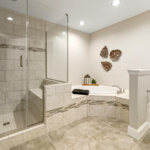The Environmental Protection Agency (EPA) suggests that indoor relative humidity should ideally be between 30% and 50%. Indoor humidity levels must remain low to prevent many problems, including pests, mold growth, stuffy air, and damaged wooden furniture. Therefore, you have big problems on your hands if your home’s humidity level is above 60%. Fortunately, there is no shortage of steps you can take to make your house less humid. Here’s how to lower your home’s humidity levels.
- Take cold showers
You likely prefer hot showers to cold ones due to comfort, but you might want to rethink this preference due to humidity. According to the Centers for Disease Control and Prevention (CDC), the average American spends more than eight minutes in the shower. Eight minutes of a constant hot shower each time you bathe releases steam into the atmosphere, making your bathroom more humid. You can invest in a bathroom dehumidifier, but it is generally advisable to switch to shorter and colder showers for better results. This is because cold showers will not release as much vapor into the air, which helps with indoor humidity levels.
- Invest in crawl space encapsulation
Crawl space encapsulation involves adding a heavy-duty moisture barrier to your crawl space’s floor, insulated walls, and sealed foundation vents. Your home’s crawl space has vents that easily allow pests and moisture to creep in. Therefore, investing in crawl space encapsulation services is one of the best things you can do to reduce indoor humidity. Crawl space encapsulation ventilates and waterproofs this area to stop moisture from building up in the house. As a result, you won’t have to deal with issues like mold, wood rot, and other types of fungal growth. In addition, you can lower your heating and cooling bill, prevent foundation damage, and stop pests from infiltrating your home.
- Open your windows
It may seem counterintuitive to open your windows when it is humid outside. However, remember that keeping air moving inside your home stops humid air from settling. Indeed, moving air is nearly always better than stagnant air, particularly with regard to humidity. Consequently, open your windows to let in fresher air and make your home less humid. You can open windows all around the house, but prioritize areas like the kitchen and bathroom since they are likely to be humid. Also, open windows that face the blowing wind’s direction to bring in more fresh air.
- Remove houseplants
It is estimated that 66% of American households own at least one houseplant. Many people invest in these indoor plants due to their environmental and health benefits. However, a major downside of indoor plants is their contribution to your home’s humidity. These plants increase humidity because they respire and photosynthesize, absorbing water to make their food and releasing almost 97% of this moisture through evaporation and transpiration. As such, it is best to put all indoor plants outside for a while during summer. Alternatively, you can put all indoor plants in one room to prevent humidity from spreading if you lack outdoor space.







